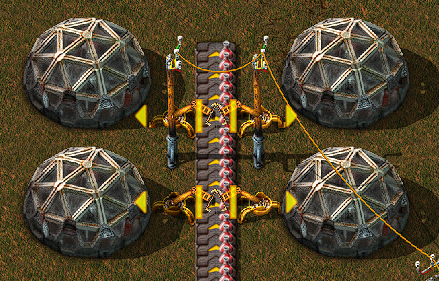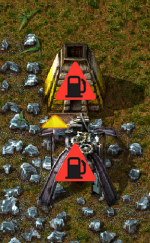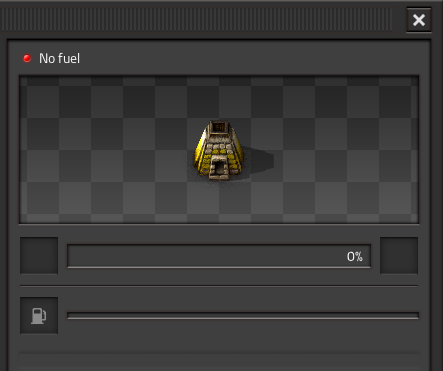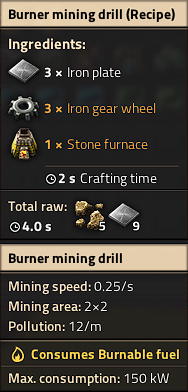User:Camponez/WIP
O começo
Se ainda estiver perdido depois de jogar os tutoriais, este guia está aqui para te ajudar.
Começando o jogo
Para começar no menu principal, você precisa selecionar "Jogar", depois "Novo jogo". Isso o levará a um menu que permite a personalização do seu mundo. Se esta é sua primeira vez, você não precisará mexer nelas. Se você ainda não jogou os níveis de tutorial e campanha, você deve joga-los primeiro. No menu principal, selecione "Jogar", "Iniciar campanha" e "Primeiros passos". A campanha "Primeiros Passos" é um tutorial básico, a "Nova Esperança" ensina mais o básico do jogo.
Gerador de mundo
Você pode alterar essas opções para gerar o mapa de maneiras diferentes. Mudanças na geração mundial podem afetar muito a dificuldade do jogo.
A primeira aba na tela da geração mundial permite ao jogador escolher uma predefinição para a geração mundial. Uma predefinição é apenas uma maneira rápida de alterar as configurações nas outras duas guias. Para novos players, a predefinição padrão ou a predefinição de recursos avançados são sugeridas.
Se o modo pacífico estiver ativado, os inimigos não atacarão o jogador, a menos que ele ataque primeiro.
A aba de Configurações de recursos permite alterar com que frequência e força os recursos e inimigos aparecem.
Resources e bases inimigas são controladas por 3 valores: frequência, tamanho e riqueza.
- Frequency determina quantas vezes você verá veias de minério ou bases inimigas dentro do mundo do jogo
- Tamanho determina o tamanho dessas veias ou bases
- A riqueza determina quantos recursos os minérios produzirão antes de secar e a densidade das bases inimigas
Se você quiser um começo mais fácil, considere aumentar a frequência, tamanho e riqueza dos recursos e diminuir o mesmo para as bases inimigas. Observe que pode ser recomendado aumentar o tamanho e a frequência do petróleo para jogadores iniciantes, pois pode ser muito difícil encontrar petróleo, dependendo da semente da geração de mundo em comparação com a de outros recursos, combinada com o fato de o petróleo ser um a necessidade de progredir, além do fato de que o bombeamento de óleo diminuirá gradualmente seu rendimento, exigindo a necessidade de viajar ainda mais para encontrar ainda mais petróleo. Observe também que o jogo pode ser concluído com inimigos desabilitados completamente (tamanho definido como nenhum), no entanto, lidar com inimigos geralmente é uma parte importante do jogo.
Mais informação sobre a geração de mundo pode ser encontrado em World generator.
Controles básicos e Interface
Por favor, veja em Keyboard bindings para aprender mais sobre as teclas e como configura-las.
Movimento
Movimente o seu personagem com as teclas de movimento ("W", "A", "S", "D" por padrão).
Mapa
Press the map key (default "M") to open and close the map. Hover your mouse over resources on the map to see what they are.
Coletando recursos
Alguns recursos podem ser reunidos manualmente, mantendo o botão direito do mouse sobre eles. Você pode usar isso para coletar Wood, Stone, Coal, Copper ore, Iron ore e peixe apenas.
Invetário e criação
Pressione a tecla de inventário (padrão "E") para abrir e fechar seu inventário. A interface do usuário do inventário é dividida no inventário do jogador, à esquerda, e nas receitas, à direita. Os quatro botões grandes na parte superior das receitas são as categorias de criação de itens. Se você tiver os ingredientes exigidos por uma receita, poderá clicar nela várias vezes para criar quantas quiser. Veja o progresso da criação no canto inferior esquerdo da tela.
Colocando e removendo estruturas
Alguns itens são estruturas que você pode colocar no chão. Quando o seu inventário está aberto, você pode selecionar uma estrutura que possa ser inserida no local, clicando nela. Você deve ver que seu cursor foi substituído pelo ícone da estrutura. Agora você pode pressionar a mesma chave de inventário novamente (padrão "E") para fechar seu inventário. O ícone do mouse ainda terá a estrutura. Mova o mouse para ver onde você pode colocar a estrutura. Se o item aparecer em vermelho, você não poderá colocá-lo lá. Se estiver verde, pode ser colocado. Você pode alterar a direção de rotação da estrutura pressionando a tecla girar (padrão "R") antes de colocá-la ou depois de posicioná-la passando o mouse sobre ela com o mouse e pressionando a tecla girar (padrão "R"). Clique esquerdo para colocar a estrutura.
Depois de colocar uma estrutura, você pode buscá-la e colocá-la novamente em seu inventário, mantendo o botão direito do mouse sobre ela.
Interagindo com as estruturas
Se uma estrutura puder ser interativa, clique nela para abrir sua interface do usuário. Geralmente, você usa isso para escolher qual receita uma máquina deve usar ou para colocar itens de estoque em um contêiner.
Ao abrir um contêiner, você também poderá ver seu inventário. Clique em um item do seu inventário e clique em um slot vazio no contêiner para transferir. Você também pode transferir mantendo simplesmente pressionado o botão "transferência de pilha" (padrão "SHIFT") e clicando nele. Se você quiser pegar apenas metade de um pilha de itens, clique com o botão direito do mouse na pilha do seu inventário. Você também pode clicar com o botão direito do mouse em CTRL para transferir diretamente metade da pilha. Se você deseja transferir TODOS os itens de um tipo, mantenha pressionada a tecla "transferência de estoque" (padrão "CTRL") e clique no item. Se você deseja transferir TODOS os itens de QUALQUER tipo, mantenha pressionada a tecla "transferência de estoque" (padrão "CTRL") e clique em um slot vazio.
Pressione a tecla "alt-mode" (padrão "ALT") para alternar para "visualização detalhada", que mostra informações extras sobre estruturas.
Barra rápida e atalho
Na parte inferior central da tela, você verá a Quickbar à esquerda e a barra de atalhos à direita. Clique com o botão esquerdo do mouse na Barra Rápida para inserir um item. Clique com o botão do meio (ou clique com o botão direito do mouse em Comando) no item na Barra Rápida para removê-lo.
Combate
Este jogo contém inimigos, embora eles provavelmente não o atacem até que você esteja mais preparado. Se você precisar se defender, pressione espaço para atirar no inimigo mais próximo do cursor do mouse. Fique de olho na sua munição, que pode ser vista no canto inferior direito da tela.
Os primeiros momentos
Recursos
Certifique-se de ter os quatro recursos sólidos próximos ao seu local de reprodução; Coal, Copper ore, Iron ore e Stone. Estes devem ser encontrados a uma distância razoável um do outro; quanto mais afastados, mais difícil será direcioná-los para uso combinado.
Também é aconselhável ter uma fonte de Water na sua área de partida, pois é necessária para o Steam engine.
Se a sua área de reprodução não possui um desses recursos, ou eles são muito escassos ou muito afastados, basta pressionar a tecla Escape e escolher "Reiniciar". Isso irá gerar novamente o mundo do jogo e você aparecerá em um novo local de partida. Isso pode precisar ser feito várias vezes até que um mundo aceitável seja criado.
Mais tarde, também precisaremos de Crude oil. No entanto, tudo bem se sua área inicial não tiver óleo, pois você não precisará dele até mais tarde no jogo. O mesmo vale para o Uranium ore.
Quase tudo no Factorio é feito com esses sete recursos básicos, e você precisará de todos eles, exceto o urânio, se pretende terminar o jogo.
Colocando minas e fornalhas
Reunir e criar manualmente é uma dor, e o objetivo do Factorio é criar máquinas que farão seu trabalho por você.
Você inicia sua jornada com um Stone furnace e um Burner mining drill. Isso significa que você só precisa colher um número limitado de recursos manualmente. Antes de tudo, você deve colocar sua broca na borda de um depósito de ferro, voltada para o forno. O depósito de ferro se parece com pedras cinza azuladas no chão.
A pequena seta amarela mostra onde o minério de ferro extraído sairá. Você deseja que o forno fique na frente dessa seta, para que a broca insira automaticamente o minério no forno. Deve ser algo como isto:
Lembre-se de que você pode pressionar "ALT" para ativar a visualização detalhada. Isso facilita a visualização do que está acontecendo.
Abastaecendo com combustível
Agora que você colocou a broca e o forno, eles precisam de Fuel.
Você pode alimentá-los com Wood ou Coal. Para coletá-los, você precisará cortar árvores ou extrair carvão; isso pode ser feito pressionando o botão direito do mouse sobre árvores ou depósitos de carvão, respectivamente.
Depois de ter algum combustível em seu inventário, clique com o botão esquerdo no forno ou na broca para abrir a interface.
Para colocar o combustível na máquina, basta clicar com o botão esquerdo do mouse para retirá-lo e clicar com o botão esquerdo novamente para colocá-lo no compartimento de combustível.
Se você deseja dividir uma pilha ao meio, clique com o botão direito do mouse na pilha. Agora as duas máquinas devem estar funcionando e automaticamente fazendo algumas chapas de ferro!
Você também pode clicar com o botão direito do mouse + CTRL para inserir diretamente metade da pilha
Você pode usar uma configuração idêntica para o minério de cobre para obter placas de cobre.
Production upgrade!
What's better than iron plates? More iron plates!
You'll need to craft some extra drills. If you hover over drill in the crafting menu, you'll see two lists of materials. The first list shows the components needed to make the drill; the second one at the very bottom of the tooltip window shows the raw resources needed to craft it. Unlike other games, you do not need to create the pre-requisite items before you select the item you want to make. All required items are crafted for you. You can see this process happening on the bottom left of the screen, where your Crafting Queue is. You can also queue up more crafting orders, as long as you have the necessary materials on you, and they'll get carried out one after the other.
Now that you can afford some extra drill and furnaces, you should automate the acquisition of both coal and stone. These are easy to set up and work essentially the same as the iron setup. For Coal, you can have two drills facing each other: they'll run on the coal they get fed by their partner and you can collect the surplus.
Don't forget that you can collect resources from machines without opening their inventories, with CTRL-LMB. You might also want to activate the detailed view, by pressing the ALT key once. You can deactivate it by pressing ALT again.
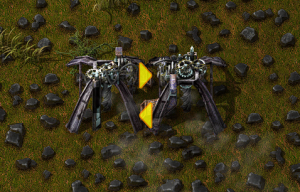
And for stone you can have the drill output directly into a chest.
Once this is all setup up, you will probably want to make it go faster. Set up more drills with furnaces for the iron, setup some for copper and maybe lay more drills on the coal to cover for the extra coal production. In the early game, the most used resource is iron, so you'll probably need twice as many miners on iron than copper, if not more. But expect copper to become more and more important the more you mess with electricity and electronics!
More automation
Great! So now you have four or so furnaces making iron, a couple making copper, some stone production and a good amount of coal production. But you know what really sucks? Having to run the coal around to all your other machines, right? Well let's automate that too! Conveyor belts and inserters are the way of the future! The output slots on the drill can also output onto conveyor belts to be transported to your other machines.
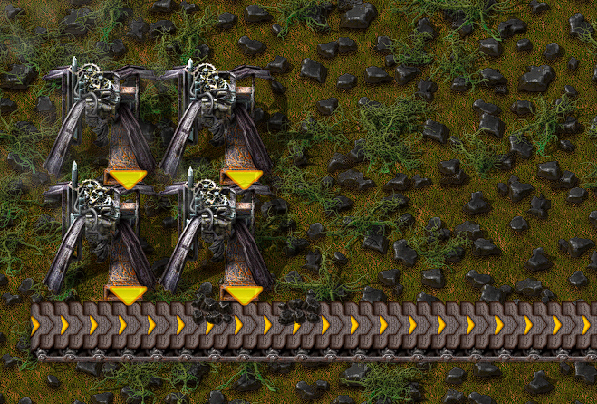
Now that we can take our coal to other places with no effort, we just need a way to input the coal into those machines.
This is where Inserters step in. In the first few stages of the game, you can use Burner Inserters as a cheap way to move items from anything to anything. You can move objects from the ground, chests, machines and put them wherever you want.
Burner Inserters themselves require coal to run though, which makes this a little counter intuitive to have to fuel them instead of the machines you are trying to fuel anyway.
Here is a small example of inserters working. Notice that the flat line is where the inserters will pick up from, and the arrow is where they will place the item. To see this in your game you need to go into the game's menu, then press Options, Graphics and turn on the option "Show inserter arrows when detailed info is on."

Okay, so now we know how to automatically mine things and then how to automatically move things from one place to another, and then to place said items into machine or out of machines.
Next up we want to get some electricity so that we can have inserters that run off that instead of fuel.
Electrical power
Electricity. This is where things start to get interesting. We're going to need a single Offshore Pump, a boiler and two Steam Engines. These are really simple to set up, they just require thirty-some iron plates per steam engine and 5 stone. The offshore pump goes in the water and needs no power to run. From there, you can either use pipes to transport the water to boilers, or you can run boilers straight from the pump. Water is fed into the boiler through the connection on the short side, as shown in the picture. If the boiler is fuelled, it will output steam in the middle of one of the long sides. The steam output of the boiler then connects to the middle of the short side of the steam engine. Make sure you connect it in the right place or it won't work. You can see where you can connect boilers and steam engines if you turn on the detailed view (press the Alt key). Boilers allow water to flow through, you can place multiple boilers next to each other and all will get water. Similarly, steam engines allow steam to run through, so you can have as many engine as you want connected in a row. Here is a small example.
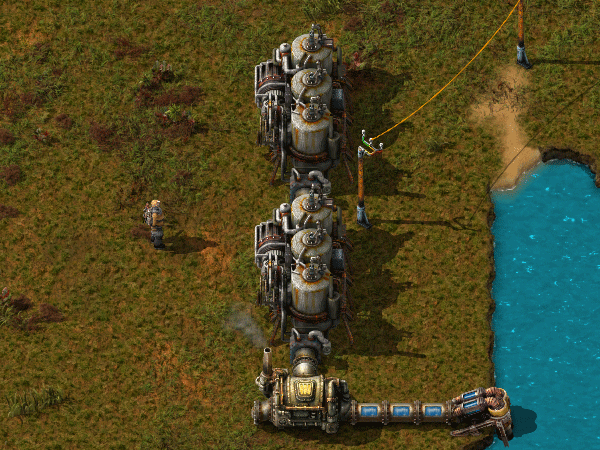
Now you need to use power poles to carry power to your machines. Place some down so that their coverage area (the blue square) overlaps each steam engine in at least one square. If they are going to connect, the machines that use power will be shown with a blue outline around their edges.
If the steam engine is producing power but nothing is using it, it'll show a yellow flashing icon: right now it's showing because we don't have electric machines yet!
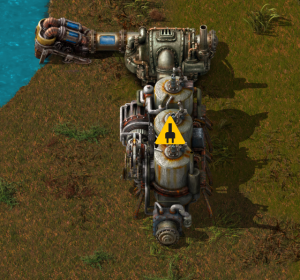
Your power setup can look however you want it to look. A boiler produces exactly as much steam as two steam engines can consume in the same time, so the usual method is to have a line of boilers each connected to two steam engines. The boilers are supplied with coal via inserters that take coal from a transport belt. A pump produces enough water for 20 boilers, so the most often used setup contains 1 offshore pump, 20 boilers and 40 steam engines. The example above is easily expanded into this efficient design. But hey, this game is all about experimentation and for you to be able to find ways to do your own things! So get to it, and show off your own unique designs!
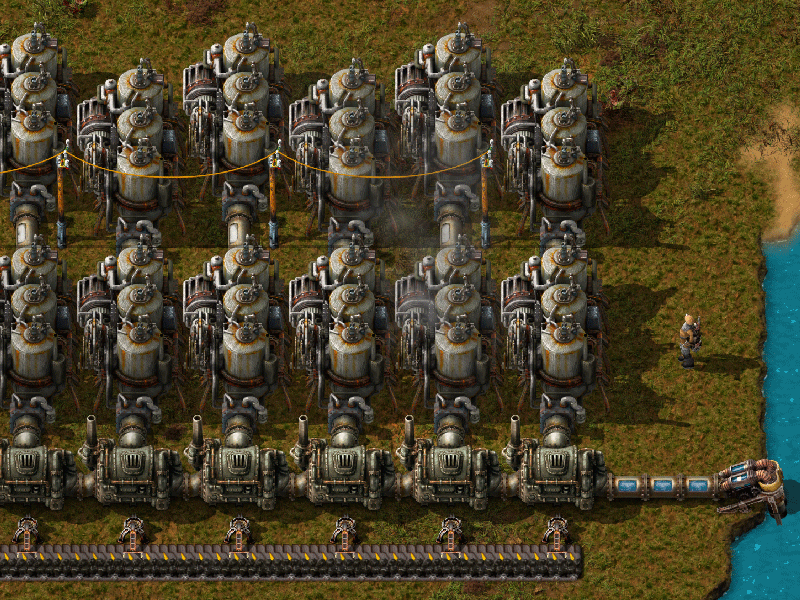
Using this power is as simple as creating a machine that runs on electricity and placing a power pole close enough to it that the blue square touches the machine, just like you have to do at the power plant with the engines. Make sure that there is a line of power poles that actually connect to your power plant.
Now that power is explained, we need to increase our resource production.
However, if you want detailed info on your power production/consumption, you can check the Detailed Electric Network Info, opened by clicking on any powerpole.
Re-thinking our resources and research
Next we really want to get onto automation of items, not just the smelting of ores.
Before we can get to that though, we're going to have increase our production of ores. This is where things start becoming a little tricky and there are few things you want to do at once. We really want to be able to set the factory to make things and let it go. But for that we need some extra utilities which we don't have and need to get through research.
We haven't even touched on that yet! Let's start by cranking up our resource production. Now that we have electricity, we can use Electric Mining Drills. These are much better than those scummy Burner ones. They work exactly the same except they are twice as fast and they don't rely on fuel, as you could guess by the names. You can have them to output your raw resources onto belts and get them to a place where you can mass process the ores into plates. Here is a small example of what you could do, but let your imagination and your calculating logic figure out other, maybe even better ways of doing it! You want ore to be split more or less evenly on each side of the belts. This helps with the amount of resources that can be carried to your base of operations on a single belt.
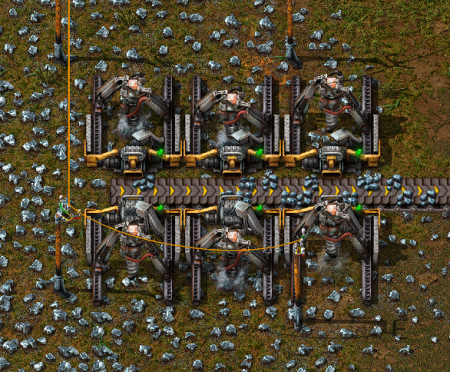
This is once again easily expandable all over an iron deposit. This conveyor belt can then take all of the ore to some sort of processing area. The processing area needs some machines that we currently don't have due to limitations in our research.
Most importantly, we want the long handed inserter. This inserter is able to reach twice as far as a normal inserter! It is very useful for bringing or placing items to or from conveyor belts that are one extra tile away. So what we need to do is to make some science labs. They don't cost too many resources, but take a little while to make. Craft one or two of them and connect them to power. When you first place one, you are going to get a popup asking you want you want to research. We really want automation right now. This gives us our inserters and the Assembling machine 1, which is going to be very useful in the near future.
You'll notice that the cost for this is 10 Science Pack 1's, or "red potions" or "flasks" as some people like to call them. These are simply another crafted item, which you should craft 10 of now and place them in your labs to begin researching. While you are waiting for your flasks to craft or your research to complete, let's continue building an ore processing center. We want a line of copper, iron and coal to be available for this area. Despite being in the electric era, our furnaces still need coal until a little further down the line.
Below is another sample of how you could set up your area. There are efficient ways of making them that you might see on the forum, but if you want to learn about what they are and how they work, you can either experiment yourself or search the wiki/forum for some better designs.
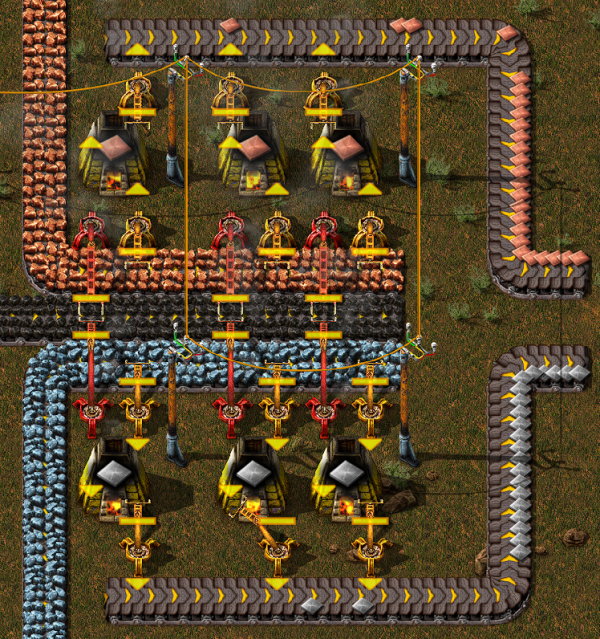
As per usual, I leave this area with plenty of room to expand later on when demands become higher. The important parts about this is that you need the red, long handed inserters to be able to reach the coal in the middle to fuel your furnaces. You need seperate belts for your incoming raw materials to be able to be processed, and then another belt outside of them to handle the output after they have been smelted. These materials can then go straight into your base to be made into a myriad of other things. Finally, we have a steady and upgradeable supply of copper and iron plates, and we can get into further automation with the assembling machines so we can automate creation of things like Science Packs, Ammunition and every other item that the player themselves can craft, but without you involved at all!
Automating that research
Ok, so a fair amount has happened. Now, to be able to progress into later parts of the game with better research we are going to want automate the process of making science packs and putting them into the labs. This way we won't have to worry about research any longer.
There are many designs that you can find on the forums, but I'll show you something simple, letting you find what works for you. I would highly recommend that you research Logistics as your next research, and in fact manually craft the science required for this. The logistic research gives you some important things: the splitter, the underground belt and the fast inserter. The splitter and underground belts are some of the most important items you'll get at this stage. They do pretty much what their names imply.
So what do science packs require? We need copper plates and iron gears. So far we have only dealt with raw resources, how do we make craftable things? The Assembler answers your prayers! If you place an assembler down and open its interface, it asks you what you would like it to craft. Once you select one, if you put the ingredients in that it requires it will craft the item and you can pull out the finished product. In the case of red science packs, we will need an assembler making iron gears, and an assembler making the actual packs. A nice way of doing this is to have a conveyor belt with 1 side containing the copper plates and the other side taking the gears from another assembler like below.
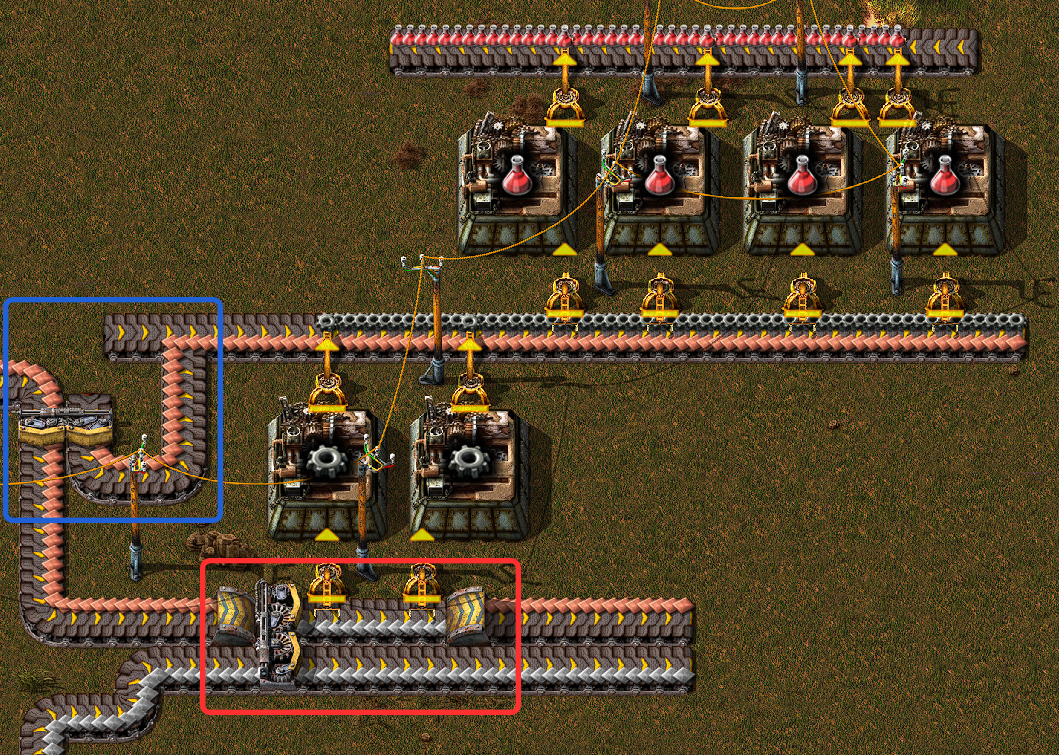
Now this picture uses a few neat little tricks that I will explain in detail. If you have your plate belts seperate, and you want them running side by side there can be issues with trying to grab one or the other resources from the far belt. Yes, you could use a long inserter, but in some cases you don't want this (e.g. you need a fast inserter to get resources quickly into your assemblers).
The area in red is a good way to get around this. By having a splitter, you can move the far belt from your production in close while also allowing it to continue down the line for later use. For the copper, we use an underground belt to go underneath the area that is now taken by the far line which also allows the copper to continue on. Once again, this is only one possible method of doing things and you are in no way obligated to follow it.
The area in blue is a quick way to allow copper to continue down the main line, while also splitting some off for our red science assemblers. Notice how when it joins the line that the gears are on, they only join the bottom side of the belt. The little extra belt that I added to the left stops the belt from becoming a turn, and therefore makes the items only join the side I want them to. The rest is simple: the gears and copper get pulled into the assemblers, they make the science and then it gets pulled out again on the other side. These flasks can then be transported to some labs to automatically do your research for you, for example like this:
